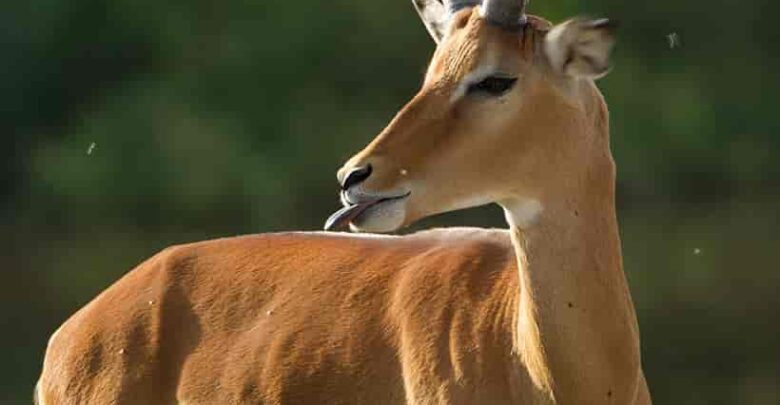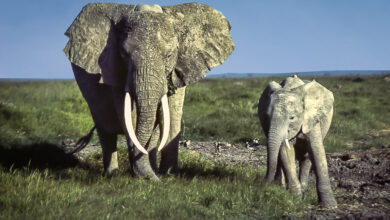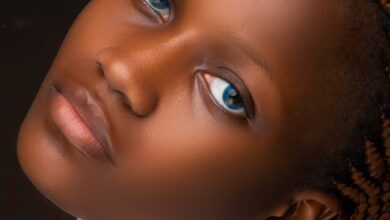African Animal Horns – Learn About African Animal Horns

The African continent is home to several horned creatures. Sadly, a lot of animals are targeted for hunting for their horns. Simply because they are horned creatures, several species are in danger of going extinct.
The African savanna is still covered in millions of these creatures.
The Bovidae family contains numerous beautiful herds that are worth admiring.
Here is all the information you need to know about horned creatures.
Learn About African Animal Horns Gazelle
A group of antelopes known as Gazella includes around 14 different species of gazelle.
Of the 14, six are located in Africa, including the Dorcas gazelle, which is widespread in Northern Africa and the Sahara Desert.
The Grant’s gazelle is among the tallest gazelles, and because to habitat degradation and human population growth, the slender-horned gazelle is now a threatened species.
The Speke’s gazelle, Thomson’s gazelle, and dama gazelle are other gazelle species that may be found in Africa.
Also Read: Meet the East African Lions that Climb Trees
Horns of African gazelles
Males and females both get horns (with a few exceptions). The horns of the females are frequently shorter than those of the males, though.
In order to establish dominance, male gazelles develop larger horns than females. A dominant man asserts himself by horn-challenging other males.
Additionally, horns are used to guard the fawn (the offspring). According to popular belief, males with horns automatically attract females for this very primitive reason.
Impala
One of the most prevalent antelope species in Africa is the impala. They run with unbelievable speed, and their astounding jumps have been recorded to be 10 meters long and 3 meters high!
They bark loudly to warn the herd if there is any danger around. They tend to separate into smaller groups when there is an abundance of food and water.
When food becomes scarce during the dry season, impala congregate in groups of up to 200 animals to look for food and water together.
Horns on impalas
Impalas only have horns on their males. These horns frequently have dark colors, bend away from the impala’s head, and have widely spaced points.
Male impala can engage in combat with other males as they contend for supremacy because they are far apart.
They feature ridges and are about 70 cm long. The horns are hollow within and have a circular cross section, yet they are powerful enough to withstand fights between males.
If a woman feels uncomfortable or there isn’t enough food available, she may decide to keep her pregnancy going for up to a full month!
Kudu
Greater kudu, one of the biggest Bovidae species, may reach a height of 150 centimeters!
The enormous horns on kudu males, often called as bulls, make them easy to identify. 180 centimeters is among the lengths of some of the longest animal horns ever measured and documented. And the kudu owns them.
Male and female kudu may easily be distinguished from one another since only the bulls have horns. Additionally, the ladies are much shorter and more delicate.
Kudu’s horns
Kudu horns are magnificent and imposing. They are frequently marketed because of their ornamental attributes. They are also used as musical instruments by several African cultures.
They can act as containers because they are hollow. Additionally, they are utilized in customary African rites and activities.
These creatures engage in conflict with other males and establish dominance with their horns. They may readily interlock thanks to their spiral design.
Gemsbok
The Kalahari and other dry areas are where you can usually find the southern gemsbok.
The northern gemsbok may be found in the wide grasslands of Africa’s more northern regions, particularly in East Africa (oryx).
Gemsboks usually gather in groups of around 10 people because they love each other’s company. When there is a lack of food and water, they separate into smaller groups or even go out on their own.
These graceful antelopes may be very dangerous when charging with their heads down and horns extended. They seldom ever need to flee from predators since their defense is so effective.
Also Read: Top Terrifying but Pretty Lovely Poisonous African Snakes
Stonebok horns
Because of its deadly horn, which may be used to spear an adversary or prospective threat, the gemsbok is sometimes referred to as the sabre antelope.
In fact, several African tribes utilize the tips as spear points because they are so lethal and razor-sharp.
Both sexes have horns, albeit the ladies’ horns are noticeably more thin than the males’. The horns are an astounding 83 centimeters long and stretch quite straight ahead.
Waterbuck
The defassa and common waterbucks are the two types of this animal.
On the African plains, they are among the animals with the worst odors. Their pungent oily secretion is probably for waterproofing and comes from their shaggy brown coats.
Wooded areas, savanna grasslands, and other areas close to a reliable water supply are all home to waterbucks.
Since they are so near to the sea, they frequently have access to a lot of food. They frequently feed on the more difficult grasses that other animals avoid.
Horns of a waterbuck
Horns on waterbucks are long and somewhat curved. Because they are always developing, an animal’s age may be determined by the length of its horn. The females of waterbucks do not develop horns; only the males do.
When they are sexually mature, the males may utilize their horns to fend off predators and to establish dominance.
The standoff might get heated when engaged in fighting with other men. The fight frequently ends when one of the two is dead.
Also Read: When and Where to Witness Africa’s Big 5
Springbok
One of the lesser African mammals with horns is the springbok. The females typically create their own herds where they rear their offspring.
A few males that have established their authority will also be present in the herd. Springboks are so named because they can jump up to 3.5 meters high!
These jumps are believed to be made to confuse predators. The correct phrase is pronking.
Depending on the time of year and what is available, springboks will consume most plant species. They like grazing on grasses as well as higher water content plants and flowers.
Horns of a springbok
Horns are seen on both men and females. Although their horns are just about 50 centimeters long, they are a stunning black color.
From the base to the tip, they have regularly spaced ridges that bend rearward.
Eland
The antelope family includes this horned species, which is the slowest one.
Eland are among the biggest horned animals in Africa. They may weigh up to 900 kg and reach lengths of up to 3 meters.
The eland can really slow down its water metabolism in conditions of extreme water scarcity by raising its body temperature.
Because of this, they may live in semi-arid regions of Africa, including Southern Africa, Ethiopia, Angola, and even Malawi.
There is a movement in Africa to replace cattle with eland. They are more drought-resistant and hardier. Their milk and beef are seen as acceptable alternatives.
Horns on eland
Eland horns aren’t very long or impressive, yet they serve the animal just well. Both sexes develop horns, albeit a male’s horn will often be shorter and thicker than a female’s, which will be longer and thinner.
The horns form a V shape with a twist at the base and a curving outward motion. Typically, they may reach lengths of up to 70 centimeters.
Also Read: Top African Safari Wildlife Park And Its Thrilling Scenery
Bongo
Some African societies hold the opinion that these animals may cause epileptic convulsions in humans. As a result, they avoid coming into contact with bongos due to superstition and beliefs.
One of the largest antelope species is the bongo. The bongo comes in two genera: lowland (western) and mountain (eastern).
When being pursued by a predator, they may achieve epic speeds of about 60 km/h thanks to their keen hearing.
The females form groupings (herds) and rear their young while the males live alone. Typically, a group consists of 5–40 people, plus their progeny.
Bodrum horns
These animal horns may grow as long as 99 centimeters, which is amazing!
A set of twisted, lyre-shaped horns are present on both sexes. The males’ horns are more impressive since they often have more twists and girth.
Wildebeest
Wildebeest are easily recognized by their anvil-shaped heads, and they’ve come to symbolize the African plains. They go by the moniker “the poor man’s buffalo.”
The vastness of their herds is one of their distinguishing characteristics. Over a million of these animals go to new pastures in the big wildebeest migration as the rains spread over East Africa.
There are two types of wildebeest, although most people are familiar with the blue wildebeest. Its head is black, and its back has a silvery color, not blue.
Although similar, the black wildebeest is substantially darker all around. It seems to be black from a distance, but upon closer inspection, it is really brown.
Horns of a wildebeest
Both sexes of the wildebeest develop horns, although the males’ horns are noticeably bigger and thicker. The horns of a mature male can spread up to around 50 centimeters in breadth.
Males impress ladies by flashing their horns. They accomplish this by thrashing and roaring in a customary show that aids in establishing territory.
Also Read: Tippi Degre: The Young White Girl Who Grew up with Wildlife in Namibia
Tippi Degre: The Young White Girl Who Grew up with Wildlife in Namibia
African buffalo
This enormous bovine, also known as the African buffalo, resides on the African plains and enjoys the marsh and savanna environments.
They are among the biggest and most productive grazers.
The African forest buffalo, West African savanna buffalo, Central African savanna buffalo, and Southern savanna buffalo or Cape buffalo are the four subspecies of the buffalo.
The heaviest buffalo weighs around 910 kg, or slightly under a tonne! And they have a top speed of 56 km/h.
African buffalo Horns
These enormous animals are distinguished by their buffalo horns.
They run along the top of the head before neatly curling off into a sharp tip, and they are fairly elaborate and beautiful.
A fused base that develops as an addition to the animal’s bone connects each horn.
Horns may grow on males and females alike. They typically measure 80 centimeters in length (sometimes even more).
Hartebeest
The term “hardebeest” is derived from “tough ox”. They resemble slightly misshapen antelope when viewed from a distance.
Strong family units exist among them, and male hierarchy is well-established. In order to keep their position as the dominant male in their region, the males frequently forgo the essential water.
That’s because they frequently find another male has taken the position of alpha when they return after looking for water.
Breeding season coincides with the rainy season, however regardless of the time of year, they will reproduce if food and water are easily accessible.
Horns of a hartebeest
The length of these animal horns is about 50 centimeters. They make an outward curve away from one another before turning back in that direction.
Ridges are also present. Both sexes get horns, which grow for the entirety of the animal’s life and vary in length depending on the animal’s age.
Ibex of Nubia
The Nubian ibex has impressive horns and resembles a goat. They live in social groups of up to 8 people and inhabit rocky outcrops in hilly areas (for females).
The males often forage alone. However, when mating season comes around, the males will spend up to eight weeks mated with a female herd.
The males must first struggle for supremacy in order to obtain this privilege. They use their substantial, backward-curving horns for this.
Ibex horns from Nubia
The fact that these horned animals engage in standoffs at great heights, perhaps on the precipice of a cliff or rocky outcrop, is what makes them so striking.
In addition to battling one another, Nubian ibex are also in danger of falling to their deaths with only one mistake.
Oryx with scimitar horns
This species, sometimes known as the Sahara oryx, has been extinct in the wild since 2000.
This resulted mostly from over hunting for their horns. They are now bred in exclusive reserves. These creatures have been successfully returned to the wild in Chad.
They can live in dry areas like deserts since they need practically no water to survive. They stick together in groups of up to 70 people rather than forming female herds or bachelor pods.
Oryx horns with scimitars
Long, straight horns with an unique reverse curvature are grown by both sexes. The horns of the female are frequently more thin. The horns, which may be up to 1.2 meters long, are a recognizable characteristic.
Rhino
The most well-known horned African mammal is arguably the rhino. The black rhinoceros and the white rhinoceros are the two principal rhino species. Due to hunting, they are now a severely endangered species.
Different civilizations value their horns. Even though there are several initiatives to stop poaching, it continues to be a terrible problem that undermines many African national parks and conservation efforts.
Rhino Horns
Although both rhino species have two horns, they often vary in size and shape.
The horns of the black rhino are rounded at the base and more uniformly proportioned.
Typically, white rhinos have two horns—one huge and one little. They appear to be slightly more “squarish” in form.
They utilize their horns to protect themselves and to find food.
Since white rhinos are grazers, their horns help them locate and eat low-growing plant material.
The black rhino is a browser and like to feed from trees; its favorite foods include leaves, twigs, and fruits.
Also Read: Facts about rhinos, including the Prepoceros rhinoceros
Giraffe
The most notable characteristics of giraffes are their tall necks and uniquely striped coats. Due to their diet, which is largely composed of plants with a high water content, they only sometimes drink water.
Giraffes have four stomachs to aid in the digestion of the plant material they ingest, which contains cellulose.
The newborn giraffe calf may drop far from its mother to the ground after it is born. However, a calf can run alongside its mother after just one day of development.
Giraffe Horns
The ossicones of a giraffe are its horns. It is unknown why they exist specifically. However, giraffe frequently employ these ossicones for self-defense.
They employ the horns by forcefully jerking their heads and necks from side to side, frequently striking their adversary with those horns.
Some giraffes have three horns instead of only two. Ossicones resemble antlers but are not because they are covered with skin.
Additionally, they vary from horns. They have a solid, somewhat fluffy sensation comparable to a giraffe’s legs.





